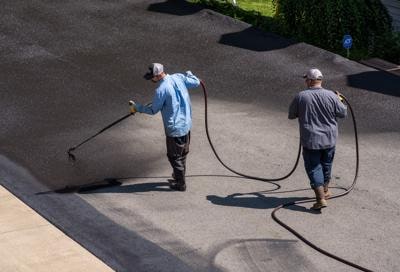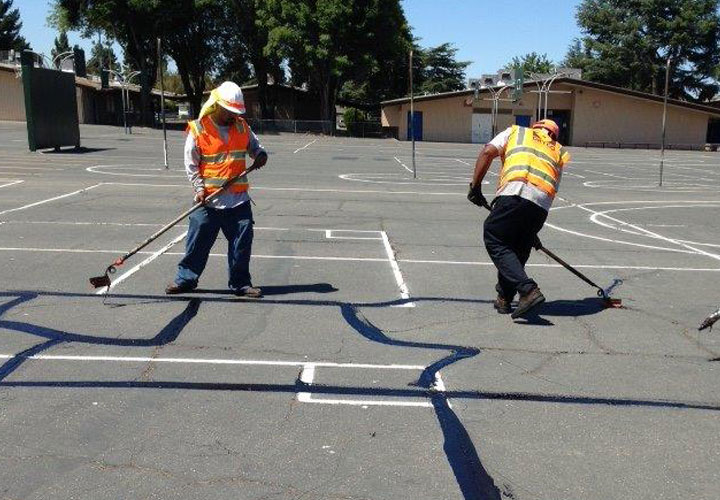Make Best Use Of Financial Investment Returns: Angled Parking Lot Perfection with Asphalt Sealing
Make Best Use Of Financial Investment Returns: Angled Parking Lot Perfection with Asphalt Sealing
Blog Article
Hot Mix Asphalt: A Sustainable Service for Sidewalk
Warm Mix Asphalt (HMA) has actually arised as a leading sustainable choice for pavement services, providing a myriad of innovative modern technologies and environmental benefits. Its capability to recycle materials and reduce energy consumption provides a compelling case for its adoption in roadway building and construction tasks. In addition, the lasting efficiency and durability of HMA make it a recommended alternative for facilities advancement. As the demand for environment-friendly building practices expands, checking out the nuances of HMA's sustainability can provide beneficial insights into the future of sidewalk options.
Environmental Benefits of Warm Mix Asphalt

Moreover, Hot Mix Asphalt aids to alleviate metropolitan warmth island results. Its dark shade soaks up sunshine, decreasing the amount of warmth showed back into the ambience compared to lighter-colored pavements. This can decrease ambient temperature levels in urban locations, reducing the demand for cooling and eventually lowering energy usage.
In addition, Hot Mix Asphalt adds to improved stormwater management. Its porous nature enables water to recharge and infiltrate the pavement groundwater materials, lowering drainage and the risk of flooding. These environmental benefits make Hot Mix Asphalt a lasting option for leading freeways and roadways.
Energy Performance in HMA Production
Is power performance an essential variable in the manufacturing of Warm Mix Asphalt (HMA)? Energy plays a considerable duty in the production of HMA, impacting both cost and ecological sustainability. One crucial element of energy efficiency in HMA production is the usage of warm mix asphalt (WMA) technologies.
In addition, improvements in plant modern technologies have actually led to more energy-efficient HMA production procedures. By optimizing power usage in HMA manufacturing, the industry can lower its carbon footprint while preserving top quality sidewalk products.
Recyclability of Warm Mix Asphalt
The recyclability of Hot Mix Asphalt (HMA) is a pivotal element of its sustainability and lasting ecological influence. HMA is among the most recycled products in the USA, with over 100 million loads of reclaimed asphalt pavement (RAP) being recycled every year in new sidewalk building and construction. Reusing HMA supplies a number of ecological benefits, such as lowering the need for virgin materials, reducing energy consumption throughout manufacturing, and lowering the quantity of waste sent out to garbage dumps.
The procedure of reusing HMA includes grating the existing sidewalk, crushing it right into smaller sized pieces, and blending it with new accumulation and asphalt binder to create a recycled mix. In general, the recyclability of HMA plays a considerable role in promoting lasting practices within the sidewalk industry.

Long-Term Efficiency of HMA
Asphalt pavements show resilience and resilience over a prolonged period, showing the long-lasting performance of Hot Mix Asphalt (HMA) The long life of HMA can be attributed to its capability to stand up to heavy traffic tons, rough weather conditions, and the results of aging. Researches have shown that well-designed and correctly created HMA pavements can last for twenty years or more with routine maintenance. The secret to maximizing the long-lasting performance of HMA hinges on using top quality products, adhering to ideal methods in construction, and executing reliable upkeep methods. Correct drainage, regular examinations, and prompt repairs are crucial for protecting the structural stability of HMA sidewalks with time. Additionally, innovations in HMA modern technology, such as making use of polymer-modified binders find here and cozy mix asphalt, have actually additionally improved the longevity and longevity of HMA pavements. By prioritizing top quality building and maintenance methods, HMA remains to prove itself as a lasting and economical service for resilient pavement facilities.

HMA: Toughness and Sustainability
Showing both toughness and sustainability, Warm Mix Asphalt (HMA) has actually become a foundation in the construction of long-lasting sidewalk infrastructures - angled parking. HMA's longevity comes from its capacity to hold up against more helpful hints hefty tons, rough weather, and high web traffic volumes, making it a reputable selection for roads, highways, and airport terminal paths. The composition of HMA, which normally includes aggregates, binder, and filler, plays a critical function in boosting its longevity and resistance to tear and put on
Furthermore, HMA's sustainability hinges on its recyclability and energy-efficient manufacturing procedure. The ability to recycle recovered asphalt sidewalk (RAP) in brand-new HMA blends minimizes the demand for virgin materials and lessens the ecological impact of sidewalk construction and upkeep. In addition, the energy performance of creating HMA depends on its reduced blending temperature levels compared to various other pavement materials, bring about minimized energy consumption and greenhouse gas discharges.
Final Thought
In conclusion, warm mix asphalt (HMA) provides a lasting service for pavement with its environmentally friendly attributes. HMA's recyclability, power efficiency in production, and lasting sturdiness make it an environment-friendly choice for road construction.
HMA is one of the most recycled products in the United States, with over 100 million bunches of recovered asphalt sidewalk (RAP) being recycled every year in brand-new pavement building and construction.The procedure of reusing HMA entails milling the existing pavement, squashing it into smaller sized items, and mixing it with brand-new aggregate and asphalt binder to create a recycled mix.Asphalt sidewalks demonstrate longevity and durability over an extended duration, showing the long-lasting efficiency of Warm Mix Asphalt (HMA) Additionally, innovations in HMA modern technology, such as the usage of polymer-modified binders and warm mix asphalt, have further boosted the resilience and durability of HMA sidewalks. The capacity to reuse redeemed asphalt pavement (RAP) in new HMA blends minimizes the demand for virgin products and minimizes the environmental Clicking Here effect of sidewalk construction and upkeep.
Report this page